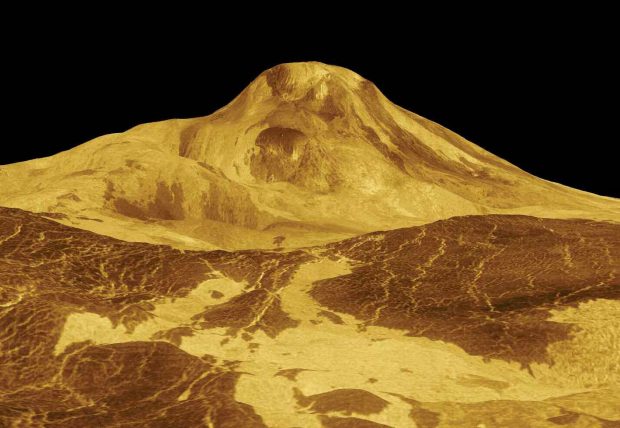
For Professor of Geology Eric Grosfils, the scorching planet Venus is a “volcanologist’s playground,” where interpreting well-preserved geological records could help lead to better understanding of volcanoes here on Earth.
Now, a $425,000 NASA research grant will allow Grosfils—the Minnie B. Cairns Memorial Professor of Geology at Pomona—and his research colleague, Pat McGovern from the Lunar and Planetary Institute, to push forward with their efforts to better understand the evolution of stresses within and beneath a volcano as it grows.
The grant proposal, “Breaking the barriers: Time-dependent, stress-controlled growth of large volcanoes on Venus and implications for the mechanics of magma ascent, storage and emplacement,” is a continuation of ongoing research started in 2006 by McGovern and Grosfils.
Their latest grant, awarded by NASA’s Solar System Workings division, provides funding for three years of research and will include a range of new opportunities for student involvement. For instance, students who are just starting their geology education can help perform GIS mapping and analysis of Magellan radar data—work that will help the research team “evaluate the sequence of eruptive events, as well as what structures were forming when, at several large volcanoes on Venus.” More advanced undergraduates can take on more challenging tasks, such as numerical modeling.
In his research as a physical volcanologist, Grosfils investigates the mechanics of magma reservoirs—bodies of potentially eruptible molten rock within the subsurface—and what causes them to destabilize. The question is an important one because knowing when and how a reservoir destabilizes and ruptures is critical to efforts to understand whether escaping magma is likely to move toward the surface and erupt.
“When a magma reservoir destabilizes and feeds materials toward the surface, it can produce an eruption, and persistent eruptions gradually build a load—a volcano—sitting at the surface. The addition of that load over time flexes the crust, however, and changes the stresses around the magma reservoir. This can either enhance the ongoing eruption or shut it down,” explains Grosfils, “and we’re striving to decipher what controls how this mechanical process will play out.”
What makes Venus, the closest planet to the sun, a “volcanologist’s playground”?
“Volcanoes on Earth get affected by a lot of different processes: our atmosphere, oceans, erosion, humans, landslides, plate tectonics … but on Venus, the geological record is in essence not compromised by any of those factors—no plate tectonics, minimal erosion, w no water, no liquid—so when something happens at the surface on Venus, the record is much more likely to be preserved for the long haul.”
The scientists will use observations derived from radar data and topography of Venus to construct numerical models they will use to examine the evolution of stresses within the crust and uppermost mantle as a volcano is growing.
Their research will add to our knowledge about the formation and evolution of the Venusian surface, which in turn helps scientists apply those findings to better understand the long-term evolution of volcanoes on Earth and the hazards they present to surrounding populations.
